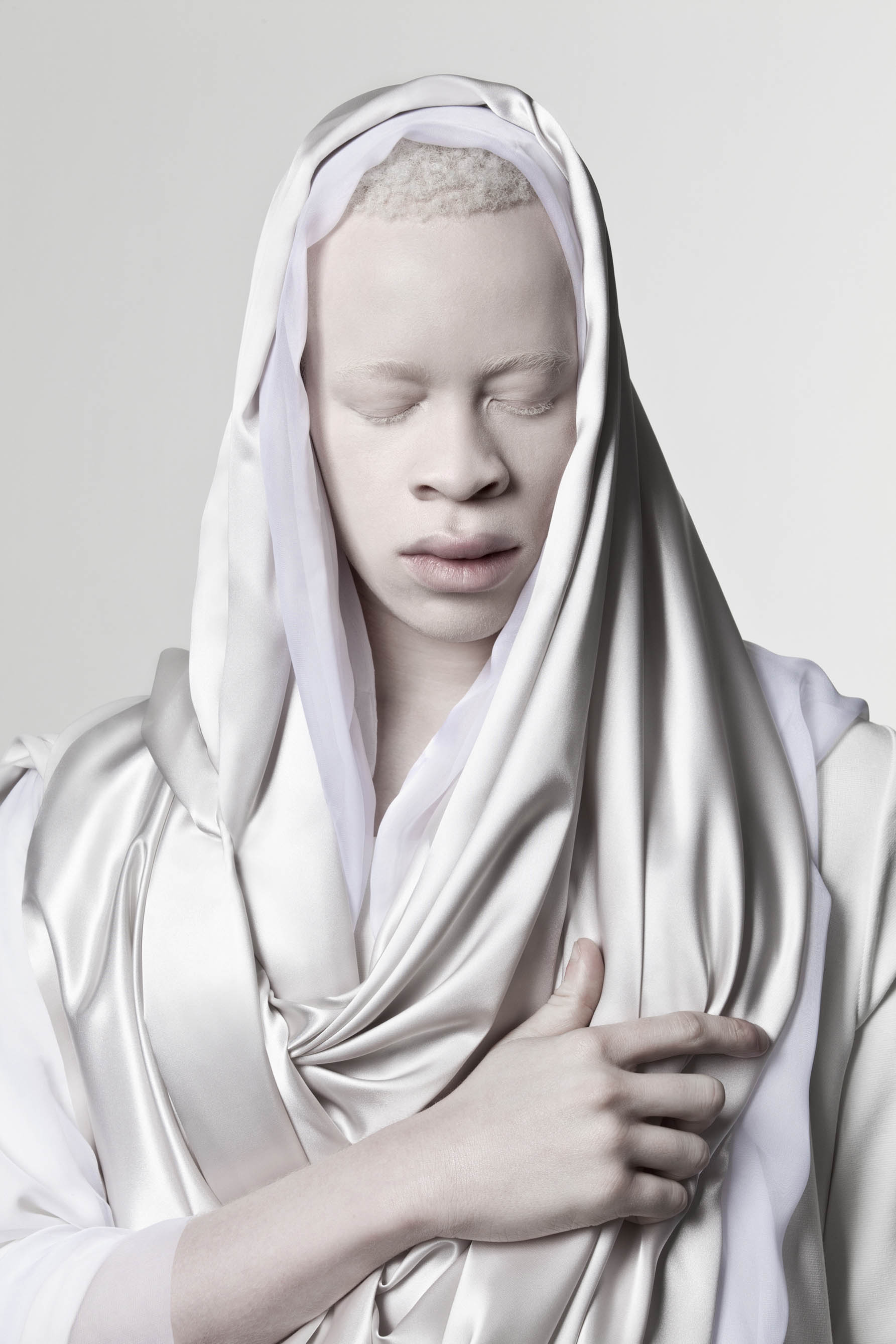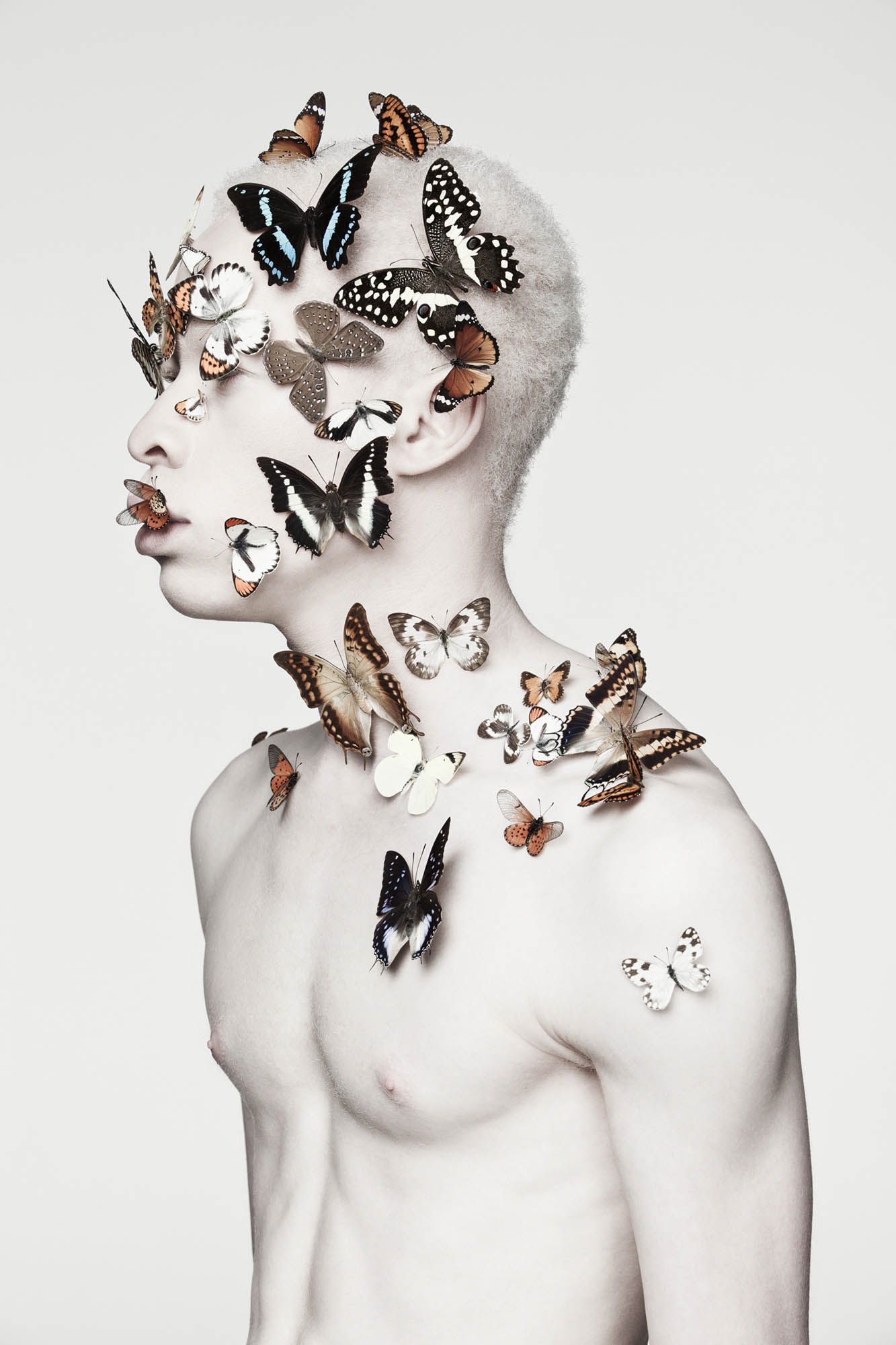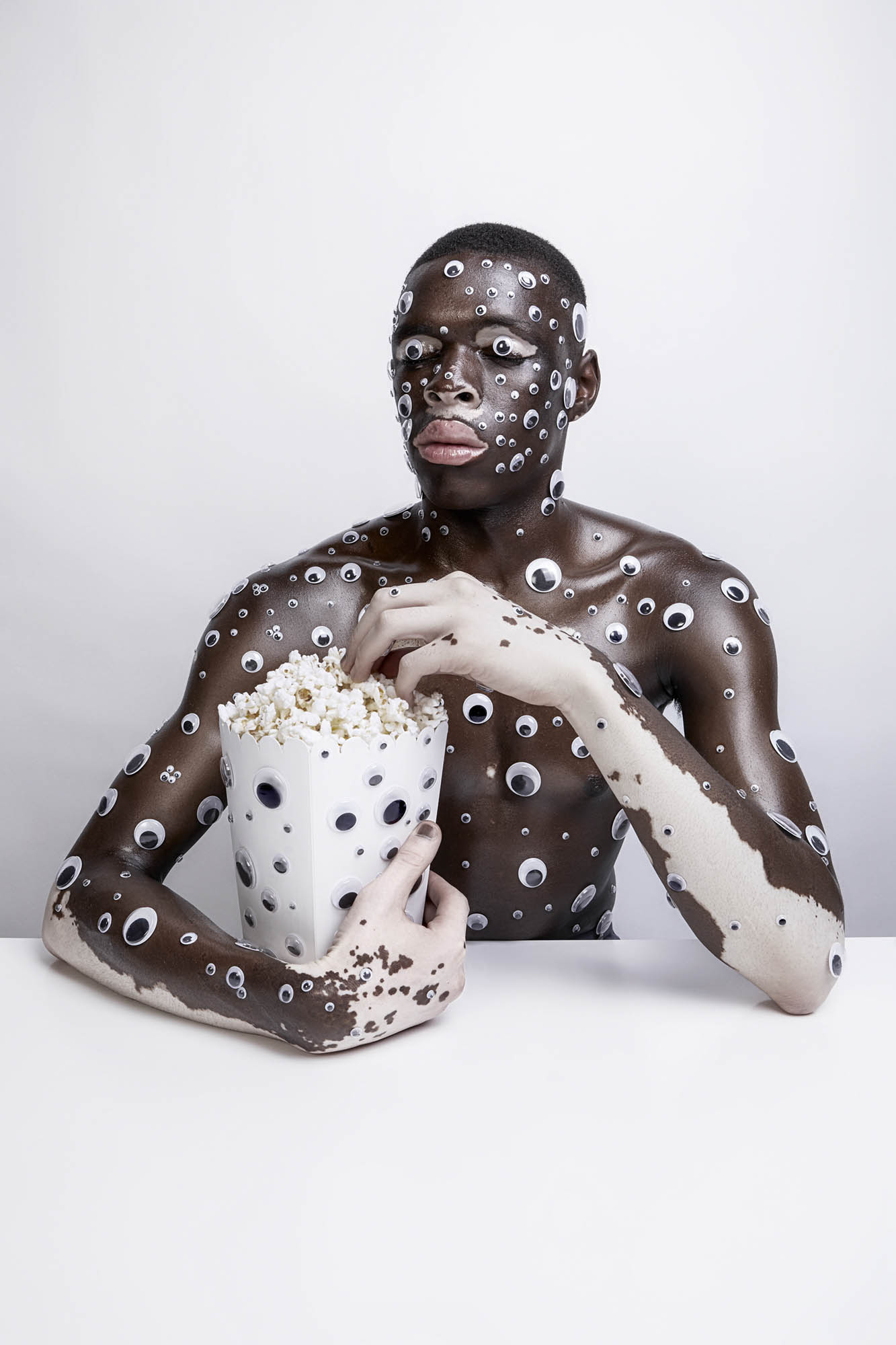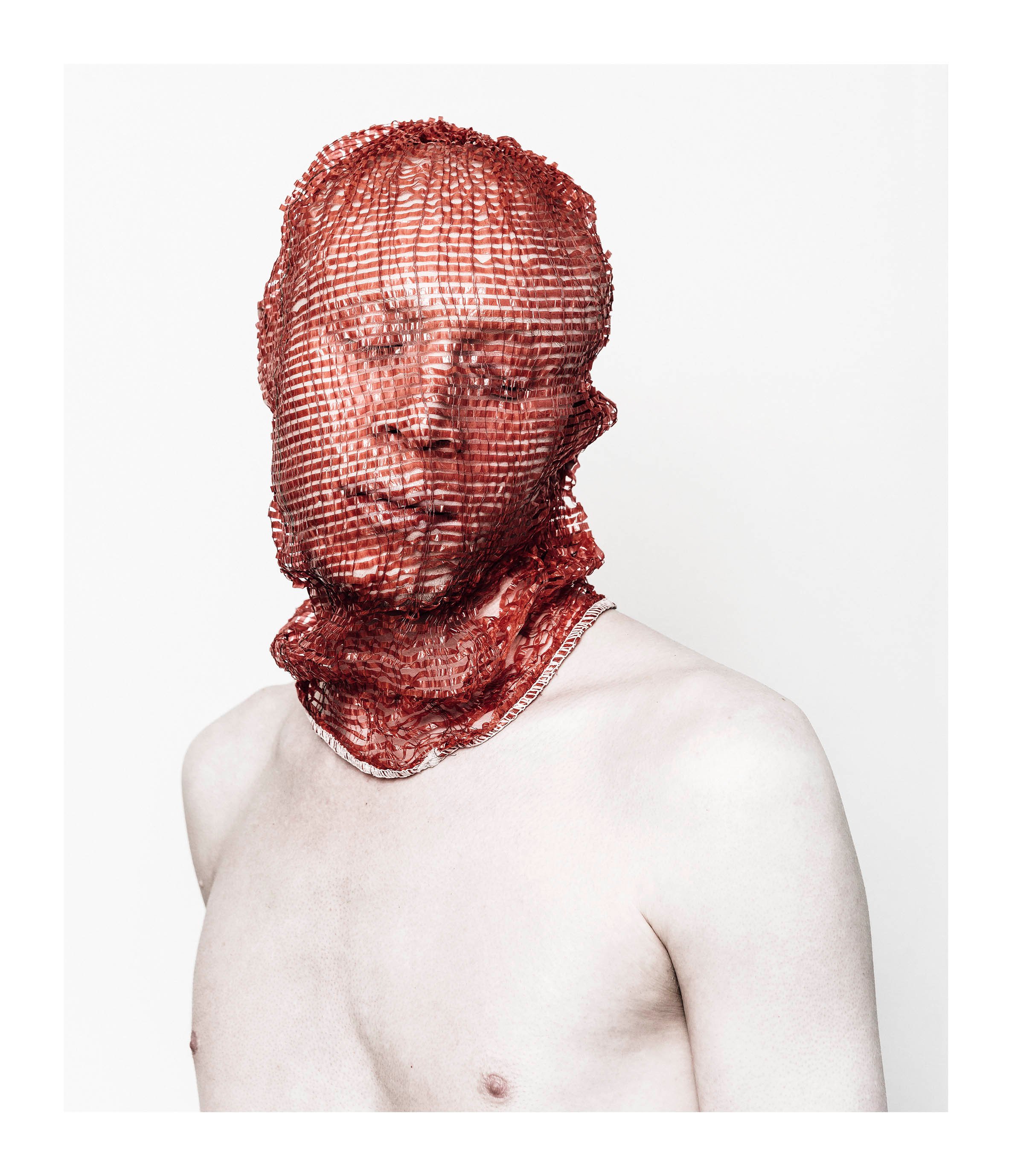There are only four images in Tatenda Chidoras photographs of Zamo Ndhlazi. Over four years, the process has evolved into a true collaboration between the two.Photo: Tatenda Chidora and Zamo Ndhlazi.
People living with albinism have long been stigmatised and othered, and the subject of superstition.
READ MORE: Bones of Gold: Report reveals how people with albinism are abducted and killed for their body parts
Some people believe that the body parts of people with albinism have supernatural properties, which can be used in potions. In film, there has been a trend of the villain role either been given to people with albinism or characters that depict their features: pale skin, platinum-blond hair and pink or red eyes. In The Da Vinci Code, Paul Bettany was cast as Silas, the twins Neil and Adrian Rayment played the dreadlocked gunmen in The Matrix, and there was Theokoles, played by Reuben de Jong, in Spartacus, all characters had attributes of albinism, which none of the actors themselves had. Albinism activists, such as Dennis Hurley, who responded to this kind of parody in The Albino Code, believe such portrayals reinforce and incite discrimination.
Recently, however, the imagery in pop culture has begun to change this by portraying albinism as desirable, majestic and alluring. Local public figures with albinism who have been at the heart of this portrayal include models Thando Hopa, Refilwe Modiselle, Sanele Xaba and actor Michelle Mosalakae.
Although the positive representation box is being ticked on pop culture’s to-do list, who is this representation serving? The people with albinism or those being praised for the portrayals?
To gain some insight, the Mail & Guardian spoke to two photographers based in South Africa who have done work on albinism — Justin Dingwall (36) and Tatenda Chidora (30).
Dingwall’s body of work is titled Albus, Latin for whiteness and brightness. It is made up of 40 portraits, which feature Hopa and Xaba. It began in 2013 after Dingwall’s first encounter with Hopa for her portfolio shoot.
“After hearing her story, I was immediately engaged,” he explains.
In the images, Hopa and Xaba are isolated, delicately and quietly positioned against black, white or stained glass-like backgrounds, which makes them appear ethereal and celestial.

Justin Dingwall’s Albus is a series that aims to subvert negative views of people with albinism
According to Dingwall, the intention behind Albus is to subvert negative narratives about albinism in a way that “is not about race or fashion, but about perception and the beauty in difference. I have worked for many years in the fashion and beauty industry and have constantly been required to photograph idealised beauty — what is seen as the norm. In my fine art work, my interest lies in the unique and the different.”

New view: Dingwall’s surreal Mob 1 (above) and Diamond 1 (below) have the effect of making viewers question their preconceived ideas about beauty.

Another of Dingwall’s series is A Seat at the Table. In it, Dingwall photographs model Moostapha Saidi, in some portraits his bare skin bedazzled with jewels or “googly” eyes. As is the case with Albus, the series is in response to Dingwall’s interpretation of Saidi’s experience with vitiligo, the loss of skin colour.
In addition to albinism and vitiligo, Dingwall’s fine art also explores the aesthetics of dark skin.
His work has earned him a solo exhibition at the Barnard Gallery in Cape Town and the FNB Jo’burg Art Fair, and has been featured in Vogue.
Chidora’s interest in photographing albinism also began in 2013 while he was studying at the Tshwane University of Technology and finding his feet in portraiture. Unlike Dingwall’s, Chidora’s body of work is made up of four photographs, taken between 2014 and 2018, after he met his current subject, Zamo Ndhlazi, from Mamelodi.

Captured. The four portaits are a collaboration between Tatenda Chidora and Zamo Ndhlazi.
“When I met him, I told him I want to photograph him. He said no. I had to woo him, I had to do my research. I gave him all the context that I had because I had no visual references. Through that we developed ideas and a friendship. Now we take one portrait every year,” Chidora explains.
Chidora has worked at this pace out of a conviction that “you have to be comfortable in front of the camera in order for the beauty and the soul behind the subject to come out”.
One of the four images, Untitled, sees a shirtless Ndhlazi clutching flowers, with closed eyes against a white backdrop, which almost makes his porcelain skin dissolve into the background in a ghostly manner.
Ndhlazi says his initial reluctance stemmed from wanting to protect his space from the world out there. But the relationship he has developed with Chidora has resulted in the snail-paced series being a collaboration. This was possible because Ndhlazi studied cinematography and topped up his visual data by obtaining a diploma in photography.
“If I come up with a concept, I own part of the photograph. When he sells it, we split it 50-50. It’s supercool how I can approach him about the work we need to create. We have become best buddies,” Ndhlazi says.
When asked about the public’s response, Ndhlazi’s and Chidora’s answers don’t seem to reflect the feelings of other people with albinism. Perhaps this is because the series is more of a conversation concerned with perfecting Chidora’s portraiture skills while celebrating how Ndhlazi no longer shuns visibility.
With regard to the desired goal for their project, Dingwall “aim[s] to make the viewers question their predetermined ideas” and Chidora wants consumers to “see past the albinism”.
Both photographers achieve this by working in the studio to control elements such as light. Dingwall also makes use of hair and make-up auxiliaries and Chidora desaturates the images in post-production. Both additions have to do with highlighting their subjects’ skin tone.
So is the act of isolating their subjects from everyday experiences by photographing them in a controlled studio a way to celebrate them? Or is it a more romantic way of othering?
For the subjects in Albus, Hopa and Xaba, there is an awareness of creatives making a token gesture towards albinism. In an interview with the online publication Live Mag SA, Xaba said: “I feel that it is becoming a fetish, along with vitiligo and other skin conditions. Photographers are jumping on the bandwagon and taking more of these images, but what are their intentions?”
Dingwall justifies his case by saying he was approached and did not seek them out. As a part of their vetting process, the models require an outline of the photographer’s motive along with the compensation negotiated by their agencies.
“The models usually have agents that deal with the admin and financial side, but the models and I do go through and sign model release forms so that everything is covered and everyone is happy,” he says.
The models also recognise how images alone cannot count as albinism awareness. However, they have used their visibility as an in to spaces about issues surrounding people with albinism.